Poultry conservationist Marissa Buchanan knows that Chinese geese are excellent guard animals, weed eaters, and all-around useful homestead birds.
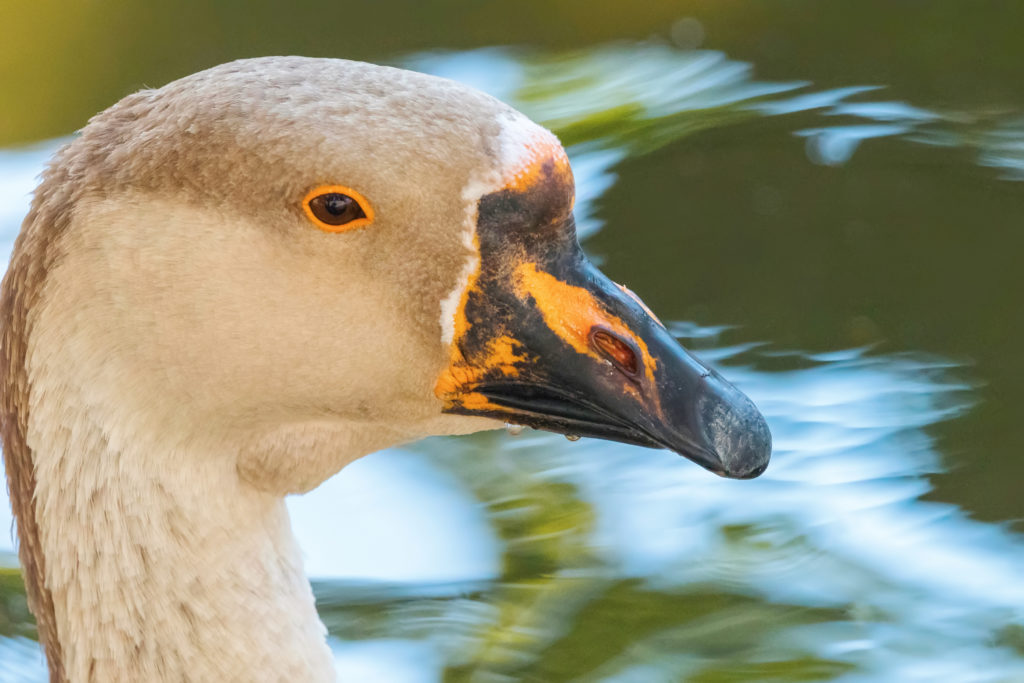
The Chinese goose is most likely a descendant of the wild swan goose from Asia. Getty Images
When looking for a goose breed for your farm, consider the Chinese goose. One of the most popular breeds, it has an amazing and culture-rich history, and makes an excellent addition to the homestead. This popular breed is used for a myriad of purposes, including meat, protection, eggs, and weeding gardens. If you want to start with Chinese goslings on your homestead, this is the guide for you!
Versatile Chinese Geese
The Chinese goose is a very hardy and low-maintenance breed. If they have free-range capabilities, they can actively graze and forage for food. This habit also coined them the nickname “weeder geese.” They were imported by farmers for this specific reason! They only need a kiddie-pool amount of water, changed daily, for breeding and cleaning habits. Chinese geese can withstand cold temperatures easily, and their egg-laying capabilities are unsurpassed, laying up to 100 eggs in a single season!
As parents, they’re excellent caregivers to their offspring. Chinese geese are also effective “watchdogs,” and can be very protective against predators while still acting sweet toward their caretakers. Breeding season for the Chinese goose is typically from February to the end of June. Outside of breeding and chick-rearing season, this breed is pretty docile.
Chinese Goose History
Like many bird breeds, Chinese geese have cloudy origins. They most likely descended from the swan goose in Asia, though they’ve developed different physical characteristics, such as longer necks and more compact bodies. However, they’re still known to have a swan-like appearance, so much so that they’re oftentimes referred to as the “swan goose.” While goose breeders speculate about why these characteristics developed (environment, diet, intentional breeding), no one knows for certain. As a distinct breed, Chinese geese were most likely imported from Asia into Europe, and then into North America by 1758 through trade with Jamaica.
There are lots of legends and stories about geese, and Chinese geese are no exception. For instance, they supposedly protected Rome from invasion in 390 BCE by (loudly) sounding an alarm as the Gauls attacked.
In the 17th century, Nicolas Robert recorded through engravings that Chinese geese inhabited Versailles’ menagerie, which later turned into a small farm where Marie Antoinette frolicked, pretending she was a simple farm girl.
Geese are native to North America, but Chinese geese may have been introduced during the 18th century. George Washington kept geese at Mount Vernon, and may have been gifted with a trio of Chinese geese at some point.
It wasn’t until 1874 that they were admitted into the American Poultry Association’s Standard of Perfection with a name and a description of what an ideal Chinese goose should look like. They were classified with both white and brown colors in the “light goose” category. By 1876, three Chinese geese were exhibited as “Chinese swans” at the Agricultural Show during the Centennial International Exhibition in Philadelphia, the first official World’s Fair in the United States.
White Chinese have white feathering with an orange bill, orange legs, and blue eyes. The brown Chinese have brown eyes, orange feet, and a black bill. Their feathering is brown with a brown stripe that runs down the back of their necks.
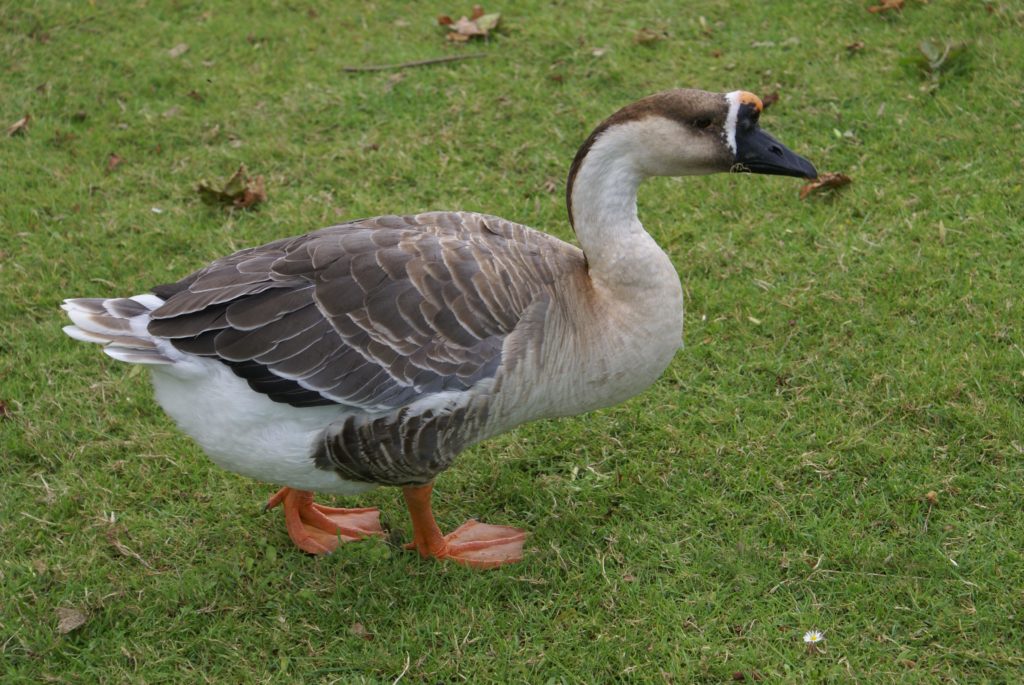
Brown Chinese goose.
Basics about Goslings
Goslings and chicks aren’t the same. Goslings need fresh grass, more water, and a different bedding than chicks. Foraging is a habit that will start as soon as the geese are born. While you may be tempted to brood your young geese and chickens together, perhaps to save space, they don’t play well together. Geese get bored easily and will pick on chicks by nibbling on their wings and chasing them. Frequent handling of goslings during the first couple days after birth may reduce some of their boredom, and it will also help them imprint on you. If they think I’m Momma Goose, I can take them out to free-range and they stay close to me.
Goslings like to clean themselves, so provide a shallow pan of water so they can bathe. With chicks, I normally use pine shavings for bedding, which is too large for them to swallow. Goslings, however, like to snack on the shavings, which can get stuck in their crops, causing an impaction. With my second batch of goslings, I started using alfalfa hay instead of shavings. This way, they could forage in their bedding, and the hay keeps them pretty occupied while you’re away. You can also give them waterfowl starter.
Health and Safety
Chinese goslings need a waterer they can dip their full bills into, to be able to clean their noses. When allowing goslings to play in water, make sure it isn’t too cold, or it will chill them. In addition, if they drink cold water, their little bodies may go into shock, since goslings still have to develop their oil glands for those amazing waterproof feathers. Sometimes referred to as the preen gland or the uropygial gland, this tiny oil gland secretes oil to the skin of the goose. The goose then takes this oil, rubs its bill in it, and spreads the oil all over its body. This in turn repels water off of its feathers magnificently. Goslings have down, and until they have their oil gland, they’re susceptible to water.
Make sure your brooder has a heat lamp, as well as an area in which the goslings can get away from the heat if they get too warm. Goslings and geese are social creatures in nature, so housing two or more goslings together will keep them happier and healthier.
Once your goslings have grown, they’ll need shelter out of the rain and wind during the winter months. This also gives them a safe place to sleep at night. A small lean-to with three covered sides should be plenty to keep them protected.
Look at Them Grow
Goslings go through a period of growth that lasts for several weeks. Use these development markers as a guide as you observe and care for your flock.
Weeks 1 through 3

Chinese gosling, Week 1. Photo by author.
In Week 1, your goslings will double in size. Their cute yellow down starts to turn white, and they stay close to you. In Week 2, they go through another growth spurt, but not as pronounced as the first. They lose more of the yellow coloring in their down. They also get a little more independent, and will roam farther away from you or the older geese raising them. If geese are raising them, prepare to see them swim for the first time!

Week 2. Photo by author.
The goslings go through another growth spurt in Week 3, so you may need to move them to a bigger brooder. They’ll still stay close when free-ranging, but they’ll forage farther and farther away. By this age, they triple in size! The goslings I raised started to eat grass more and more each week, and left more starter feed behind each day. During Week 3, their water consumption also increased significantly.
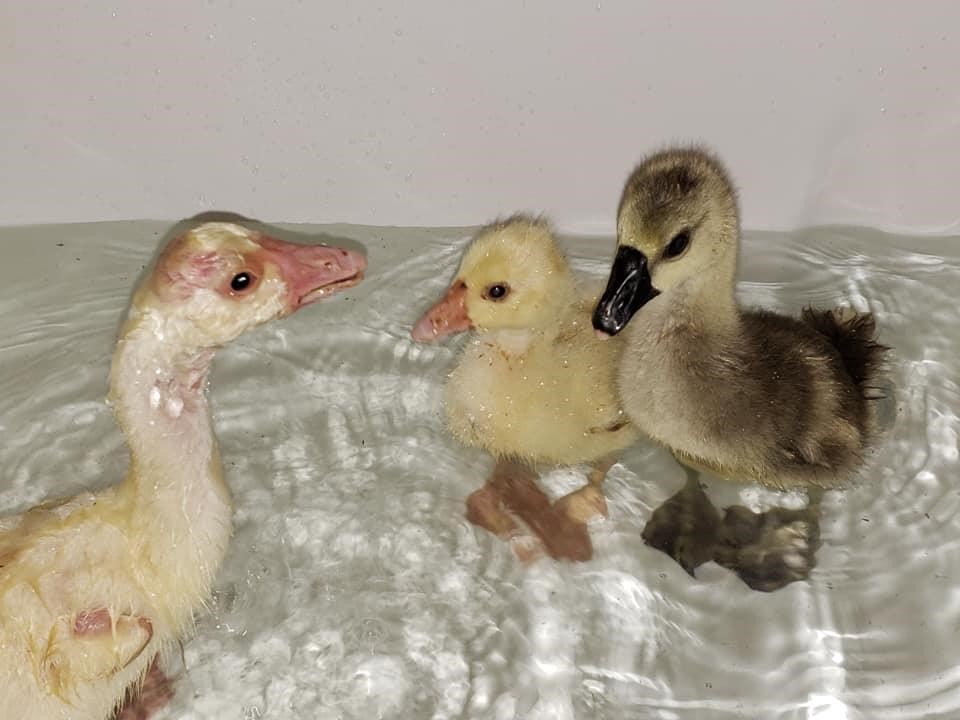
Week 3. Photo by author.
Weeks 4 through 7
There aren’t many changes in Week 4. The goslings roam away from you, but if they stray too far, they’ll quickly place themselves back where they can see you. During Week 5, another growth spurt happens! Even though they still have their chirp, you’ll hear a little rasp behind it, and the goslings will get whiter by the day. During Week 4, I had to move my goslings from the brooder to the coop. They were about half the size of hens, and they grew very quickly.
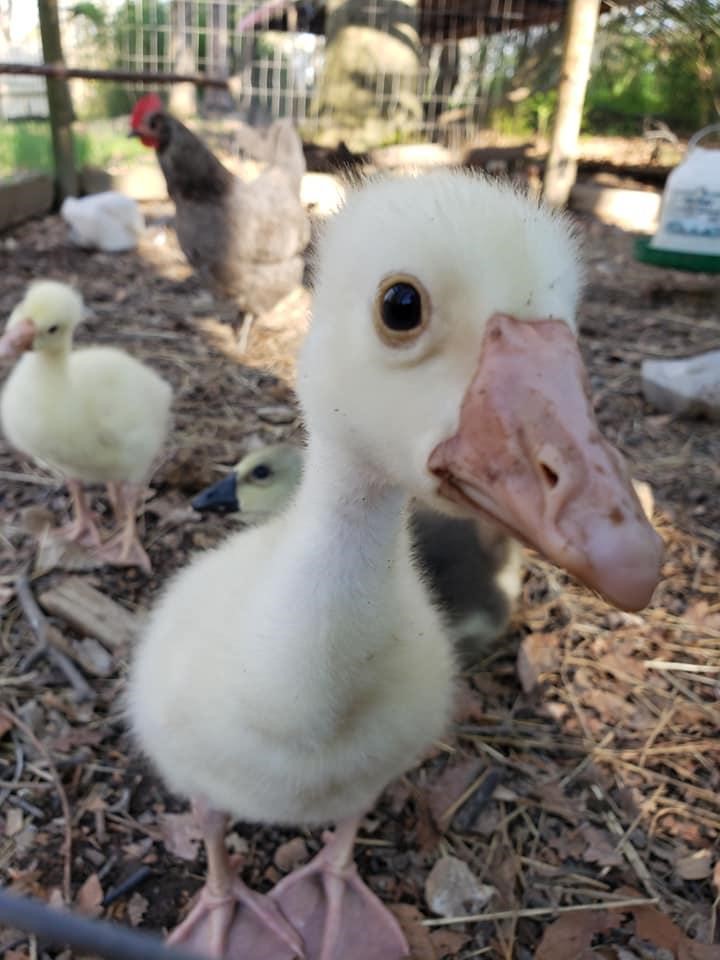
Week 5. “I’m talkin’ to you!” Photo by author.
During Weeks 6 and 7, no major changes occur, though you may note an interesting observation: Whenever the goslings approach anything unknown, they lower their heads down and stretch out their necks.
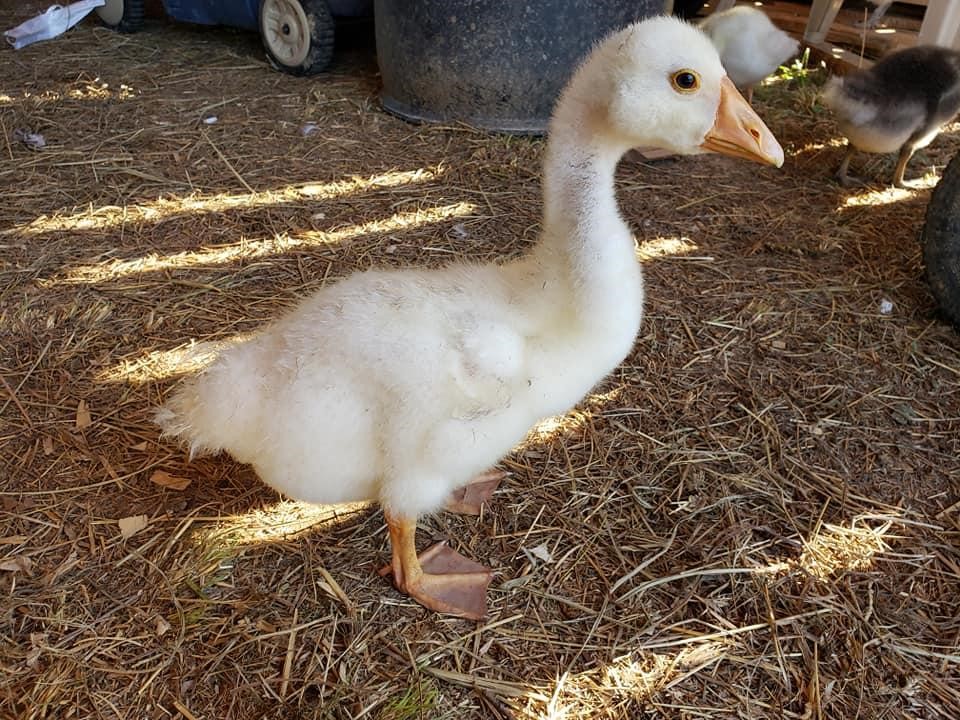
Weeks 8-12
Major changes take place during Week 8. The goslings’ oil glands start to develop, and they become more waterproof by the day. Their yellow coloring is almost completely gone, and their baby faces change to teenage faces. They won’t follow you to hover nearby at this point, but instead will only come find you for petting or if they need something. Another growth spurt happens, and they get to be as big as a medium-sized hen! You’ll also noticed your goslings’ chirps are gone, and now they honk. If any of your goslings has a pronounced knob on the top of its bill around 8 weeks of age, odds are you have a gander!

Eight to nine week old goslings. Photo by author.
At this point with my goslings, they were still friendly with me, but I turned them out with their parents and my flock of ducks. They were still growing, and by Week 12, all of their big feathers grew in. They foraged and played in water most of the day.
Owning geese is a joyful experience, and raising them is an eye-opener for how quickly these fluffy, little, yellow goslings become adolescent geese. It happens quickly! They’re hardy, friendly creatures that love to forage and are careful of strangers. They’re also social creatures, and if you raise a flock of them, you’ll fall in love.
Marissa Buchanan grew up an active member of Future Farmers of America. She was raised on a cattle farm, and has experience with gardening, poultry conservation, animal assisted therapy, and gardening therapy, and she hosts the biannual Heritage Breeds Festival in Riceville, Tennessee. She served in the Tennessee National Guard for 10 years as a combat medic, and received her Bachelor’s degree in health care administration. Marissa is currently the owner of Buchanan’s Barnyard, a mini-pig rescue and poultry conservation farm. She’s also a mom to two toddlers and is married to her high school sweetheart.













18 Comments
I have found that the temperament of the brown an white Chinese geese is very different. The brown females can be VERY docile, when hand-raised and lots of handling. While the white can be some of some of those geese that gives the species a bad name. And if you let them in your garden, expect either of them to eat their favorite fruits and veggies, lol.
I’m hoping to have gosling this spring for the very first time. Last spring I was given an Ebden Goose and a African or Chinese Gander. They have been mating steadily for the last week. Lucy is 4 and Luey is 3. The previous owner said she found 1 egg but nothing developed.
I have a question: What did you feed the gosling?
I have been “adopted” by a adult brown Chinese goose. He has been on the lake I live on for years. For some reason this year in August He started coming to our garden to eat our lettuce and tomatoes. He also would eat the knocked down bird seed. The winter seasons before he always went somewhere else…I live in the mountains. This year he didn’t. I got him assorted grains to eat which he enjoys and comes twice daily to eat. He sleeps here during the day. I have named him Wally since he seems to have imprinted on me. Years before we had seen white geese on this lake but haven’t for quite awhile now. I have 2 questions. Why has Wally imprinted on me? And why does he eat our Georgia clay with his grains? He really muddies up his water bowl. Is it nutrients he’s needing? If he’s going to hang here I want to do right for him. Please advise. Much appreciated!!!
Thank you-Ann
I need a little help!
We are new to Chinese Geese, we have four. We adopted them as gosling to guard our flock of egg laying chickens – we handled them, hand-fed them, let them nap in our laps. The geese are now three months old, and are extremely aggressive to us! Attacking us when we go into the chicken yard, biting and hissing – we cannot turn our backs on them! Help!!
I am going to send two to the butcher and hope that they remaining two might settle down and be less aggressive. If not, they too shall end up on the dinner table.
Any suggestions? I really hate to ditch this effort, they are beautiful birds and seem to do a good job at alerting the chickens when hawks are in the area.
Would really like some advice.
Thanks.
Chinese geese in stock
Thank you for the detailed information. My first goslings arrive in about two weeks. I’ve always wanted geese, and this year is the year. I already own chickens, ducks, turkeys and guinea, but I understand geese are a whole new field. I’ve chosen Chinese geese after researching the breeds available.
I’ve got a baby Chinese goose born a week ago. It keeps flipping on its back i wad told it’s a nero issue is there anything I can do
they need b vitamins and folate for their nervous systems. probably hatched from parents lacking proper nutrients
I have a baby that hatched a week ago I was told it is a nero problem. Because it keeps wanting to flip over is there anything that I can do
What a lot of people see as aggressive behavior is actually just the Chinese geese personality.they make great pets when raised correctly.
I must honestly confess that I don’t like this breed. I hatched some eggs that a friend gave me under a foster Muscovy duck mother. Even at a very young age (they still had down only), the goslings were merciless bullies and brutally attacked the ducklings, even though they were hatched and raised by a Muscovy duck and around ducklings since birth (hatch). I had to separate them. They are beautiful and graceful, but I’ll never get any more. Never had problems with graylag-type geese ever doing this. Chinese geese can be aggressive toward humans too, something to definitely watch out for if little children or people who aren’t used to farm animals are around. My favorite goose breed is the American buff.
I acquired a Chinese goose a couple years ago when the neighbor accidently killed her mate. I had Peking females so the goose came to live with them. I have now lost the ducks. She is very lonely, and is now following our dog all around and she gets very close to Elsa (the dog) and lowers her head and her wings quiver. What is she doing?
also I have purchases a Chinese male gosling and two Saxony female ducks. I’m hoping that my goose will will want the gander when he reaches adulthood as a companion. When the gander is grown, will he bother the female ducks? I had 2 Indian Runner males that I had to rehome, they were killing my chickens and always getting on top of my goose.
Ms. Sherri,
Your Goose is very lonely and is looking for a mate. My chinese geese are pretty good about leaving my ducks alone, but they are free range.
When are they full grown? Mine is 9 weeks mostly white size of a duck..
Hi. I have a Chinese goose and a Pomeranian goose both male. But I bought a baby goose female. Is that bad?
i’lltry —have ducks & chickens
Can they survive in subzero temperatures?
Survive will depend on a lot. On their own, outside? No. If they have a warm place to stay with a heat source, probably yes. Chinese geese are prone to frostbite, so keep them warm.